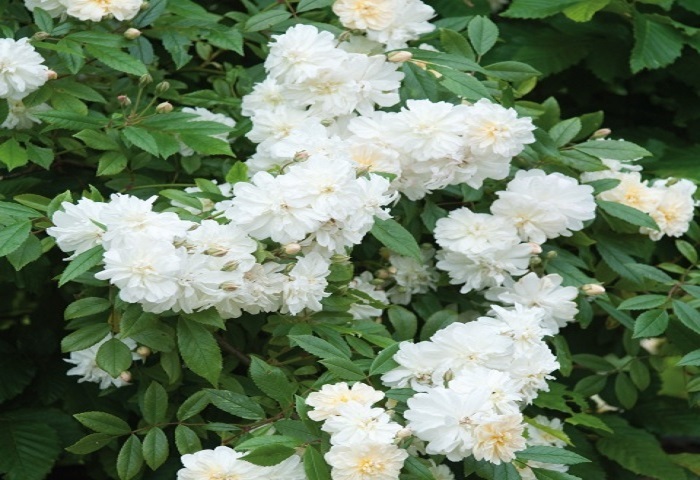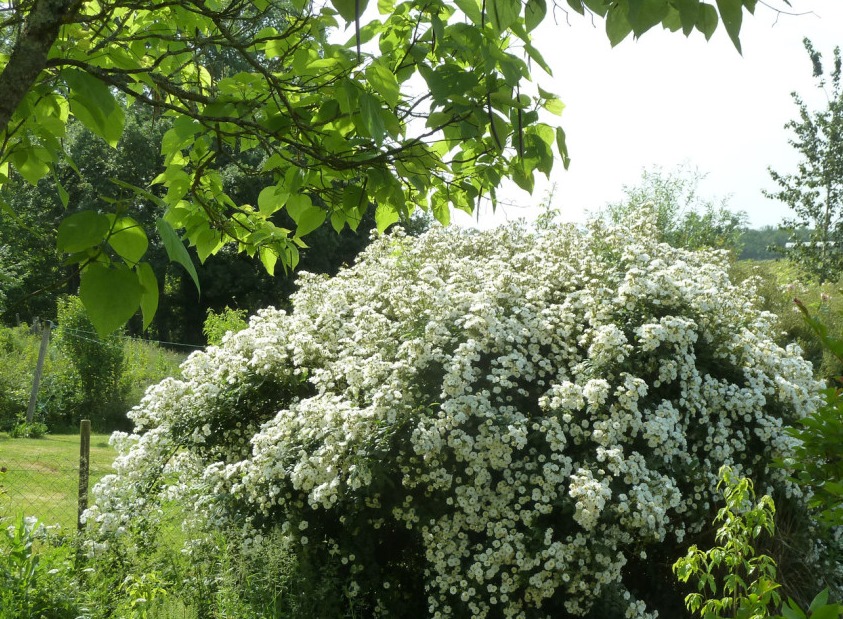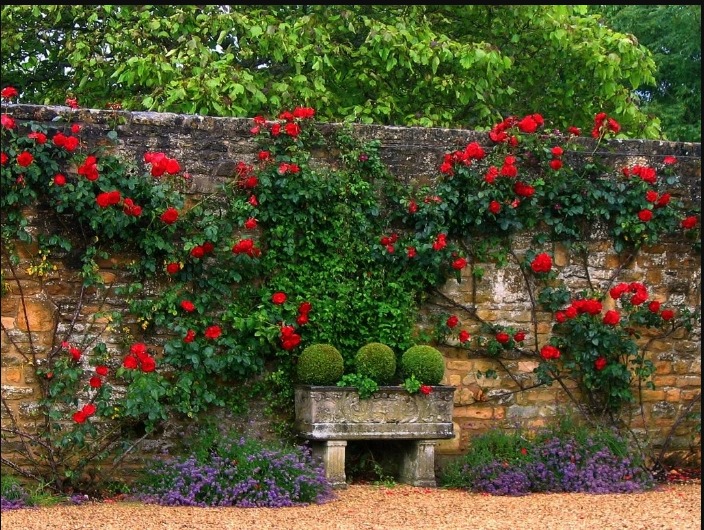Care, transplant and types of climbing rose.
Content
- Weaved rose - winter -hardy varieties, blooming all summer with small colors: name, photo
- Weaved rose - winter -hardy varieties, with large flowers, blooming all summer: name, photo
- Correct landing or transplanting climbing, curly roses in the spring: terms, technology
- When to open climbing roses after winter in spring?
- Webly rose: care, circumcision work in spring
- Spring feeding of weaved roses: fertilizers
- Caring for flowering climbing roses in the summer: Description of work
- Autumn pruning of climbing roses after flowering and preparing for winter: Description
- How and when to cover the climbing roses for the winter correctly?
- Reproduction of climbing, curly roses with layering, cuttings: Description
- How quickly the climbing rose grows and when does it bloom after planting?
- Why the climbing rose does not bloom: reasons
- Diseases of weaved roses and their treatment
- Webly roses in landscape design: photo
- Video: Planting climbing and curly roses
Miniature and voluminous, bright and delicate, exotic and ordinary, aromatic and smell - climbing roses are diverse. Due to their diversity, they are very in demand among gardeners of different regions of residence. We will talk about these unusually beautiful and popular colors in the proposed article.
It is not possible to list all the varieties of the flowers in question in the framework of one article, so we dwell on some of the particularly loved gardeners.
Weaved rose - winter -hardy varieties, blooming all summer with small colors: name, photo

- Bright saturated buds in size not more than 4 cm, resemble fuchsia in color
- A very unpretentious variety, which, due to its compactness, is often used to decorate trees or arches in combination with other species

- Late opening buds, compensate for this lack of variety duration of flowering, literally to the most frosts
- The length of the shoots reaches 2.5-3 meters, the width of a separate bush is about a meter
- Typically, the flowers have a bright raspberry color, sometimes other tones are found, depending on the variety of varieties

- Delicate and neat flowers are formed in the form of white small balls that bloom almost continuously
- On one brush, from 5 to 20 buds are formed
- Very unpretentious, almost do not require additional care

- He is a bright representative of chameleons. At the beginning of the maturation of colors, the color of the ivory has the color of it, which after some time turns into a pale white color
- The buds are located in the form of a vine, on which up to 50 flowers grows
- The length of the bush can reach 5.5 meters
Weaved rose - winter -hardy varieties, with large flowers, blooming all summer: name, photo

- Bright red flowers do not lose their saturated coloring even under scorching sunlight.
- At the beginning of flowering, the diameter of the buds is about 10 cm, after a while they smaller, but remain very large and beautiful.
- An unpretentious look, capable of growing on soil with different composition, is adapted to various climatic conditions.

- The perfect variety, according to gardeners. Apricot or pale corral buds bloom all summer, have a diameter up to 30 cm
- The bush is not high-up to 2 meters
- Suitable for low hedges and small arches

- Very unpretentious to care and frost -resistant variety
- Each bush has a height of 3 meters and a width of 2 meters
- Burgundy buds, 12 cm long

- An unusual pale lilac shade gives the flower some exoticism, against which green leaves are harmoniously released
- Bush height 2.5-3 meters
- Requires very careful care

- Terry flowers of bright yellow color ideal for decorating vertical surfaces
- The disadvantage is the presence of large spikes
Correct landing or transplanting climbing, curly roses in the spring: terms, technology
- The optimal time for transplanting is early spring, until the first leaves appear
- First of all, we install the supporting structure that will hold the bush and will make it possible to make a beautifully designed plant
- Next, we dig the roots in the circular, at a distance of 30 cm
- Gently pull out the plant
- Shake off the remains of the soil from the roots
- We soak root shoots for 24 hours in a solution of water with any rooting biostimulator (“Kornevin” or “heteroauxin”)
- We cut the weak and dried shoots, leaving 15-20 cm of strong branches. This makes it possible to activate the growth of the green crown
- We treat the sections with coal powder to prevent damage by various infections
- Then we prepare the planting hole with a depth of 50-65 cm. The distance from the bush to the bush is 1 meter.
- We lower the root system into the pit, distributing smoothly and neatly on the soil, without bending, 10 centimeters in depth
- Then we sprinkle with earth
- We tamp it
- Water well
- We tie transplanted plants on vertical supports
- We have the main branches horizontally, for more beautiful growth
When planting a lane rose, it is important to consider the following points:
- Excess moisture in the soil is harmful to a decorative plant. This causes rot and death of the root system. To avoid this, it is necessary to create good drainage at the bottom of the planting pit.
- For the balance of soil acidity, sprinkle along the bush a mixture of a glass of wood ash and bone flour.
- All roses are photophilous and thermophilic plants. They do not tolerate shading in buildings or garden plantings.
- Take open areas with light loamy soils under the rose.
When to open climbing roses after winter in spring?
It is necessary to take into account the timeliness of the opening of the plant after the winter period:
- Early removal of the shelter can lead to damage to the kidneys by belated frosts
- Later - fraught with damage to rot and blackening of the bush
Optimally remove shelter:
- When thawing land 35-50 cm deep
- When establishing a stable plus temperature during the day, and at night a small freezing
The time for opening roses depending on the region of growth:
| Region | Period |
| Moscow Region, middle strip | April 10-20 |
| Ural | April 15-25 |
| Siberia | April 20-30 |
Webly rose: care, circumcision work in spring
- With the onset of warm days (the beginning-invent of Marta), the exposed surface of the winter frame shelter from the frame and the rose bush itself, throw in snow. This will help protect flowers from the spring temperature difference in the daytime and at night
- After 2 weeks, remove the remnants of snow, carry out a groove to remove melted water
- Carry out a daily 20-30 minute ventilation, opening shelter on both sides
- When it becomes much warmer and there is almost no snow, start preparing for the complete opening of the plant. To do this, open one or two sides on the sides of the shelter for ventilation. Next, throw the covering material, leaving a small outlet so that the flowers can breathe.
- After a week, free the roses from protective material from the east or north, at your discretion.
- After a couple of days, you can completely open the bushes and remove the leaves from the soil.
- Now we make a cosmetic pruning, removing broken, dried or crippled by cold branches to an entire part
- Next, we irrigate from infections of copper chloros or copper sulfate
- We hill and cover with a spruce or thin agrofibre, lutrasil or fabric
- With the onset of a stable plus temperature, in the absence of a risk of night frosts, we make the main pruning, giving the desired shape to the bush and deleting weak shoots
- Immediately treat from diseases and pests all the same copper sulfate
- We make top dressing from a warm infusion of mullein 1:10, with a calculation of 10-15 liters per bush
Spring feeding of weaved roses: fertilizers
- At the end of April, we apply nitrogen fertilizer or mullein solution, ammonia nitrate, humus. We carry out the next top dressing after 2-3 weeks, and when the buds are formed, we feed the Calcium nitrate, diluted at the rate of 1 tbsp. l. 10 l. water, or any complex fertilizer. At the same time, we apply all fertilizers in liquid form, using approximately 3 liters of liquid on one bush.
- We water the roses often, at the first signs of soil drying.
- To preserve moisture, we mulch the earth around the bushes.
Caring for flowering climbing roses in the summer: Description of work
The key to beautiful and long flowering of the culture in question:
- Competent watering
- Timely top dressing
- Cutting
- The fight against diseases and pests
- Loosening and mulching soil
- Watering. For good vegetation, roses require a plentiful amount of water. If there are no rains, with the advent of the first inflorescences, watering once a week at least 10 liters per bush. After a couple of days, we loosen the soil well or mulch. At the same time, excessive watering from the hose increases the concentration of moisture in the air, and this is fraught with the occurrence of fungal diseases.
- Top dressing. Weaved roses of more than other species require regular top dressing. All the time of flowering, we feed them once every 2-3 weeks, alternately changing nitrogen-containing fertilizers to complex. We use fertilizers in dry or liquid form.
- Cutting. Good care for roses gives an increase in long shoots up to 2-3.5 m. Depending on how roses bloom, pruning is carried out once or twice in the summer:
- In the first case, buds are formed on the stems of the formed season formed. The formation of their flowers ends on this. The spent branches are replaced, these varieties of roses are thrown about 3 to 10 new processes that are ready to flower the next season. Such faded processes are sequent without a trace.
- Blooming stems on the main offspring in a three -year period are re -formed. Since the buds on such branches no longer bloom in the fifth year, we remove most of the shoots four years later from the date of formation. When forming a large number of fresh processes in these branches, we remove the main branches, like a cutting of the first species.
Autumn pruning of climbing roses after flowering and preparing for winter: Description
The beginning of preparation for wintering we start in the summer months:
- In July, we radically change the structure of top dressing. In the spring, the floral culture had a nitrogen -containing feeding, which activated the growth of culture. Closer to autumn, the seedlings become necessary for feeding, with the content of potassium and phosphorus compounds. This is due to the fact that in the absence of a change of top dressing, the young shoots will continue to form, and with the onset of even small frosts it will receive frostbite, which will lead at the time of the thaw to rot.
Potassium feeding contributes to a delayed stem, giving it more resistance. Phosphorus has a positive effect on the roots of the bushes and gives a good incentive for the formation of inflorescences and kidneys. We finally carry out fertilizer of plants on the 15th of September - this will enable the bushes to prepare for wintering. - Without waiting for the first frosts, we carry out some more manipulations to slow down the growth of the plant, with the aim of stripping vines and stopping the growth of the root system.
To stop the process of forming new kidneys and processes, we stop pruning shoots.
In order for the rose to overwhelm well in any case, we do not remove the existing buds from the bushes - At the end of autumn, we remove the entire deciduous cover from the branches.
- Next, go to the pruning stage. This must be done to facilitate covering the cut bush, in order to prevent freezing and infection with parasites and pests. We carry out sequestration with the advent of five -degree frosts. This will enable the bushes to harden and survive under more severe conditions. During autumn pruning, we eliminate the vines that can harm a garden rose: infected parts are dangerous for the whole bush. In addition, we destroy broken, frail zones, dried buds and herbs. We leave strong transgresses no longer than 0.3 meters.
How and when to cover the climbing roses for the winter correctly?
- For regions with a warm climate, simple hiding on the support rack is suitable. By the diameter of the plant growth on the ground, place the spruce or fix it to the branches with a rope. Next, the structure is insulated with lutrasil.
- In the middle latitudes, a more thorough way of protection will be required:
- Without waiting for a strong cooling, remove the branches from the supports and bend to the soil. There are types of roses that have a tight trunk, bend it in stages, fixing it with iron brackets. Do not allow the tops of the tops of seedlings with soil.
- The plants that have grown too wide in the arbitrarily selected zones are tug around with a rope, preventing the needles with the opportunity to injure the stems.
- You can make a detachable frame, placing it next to the branches. A support is created above them, which is covered with a film.
- A simple way to preserve plants is to bend the stems to the soil, fix them with a rope and insulation with a layer of fir legs. On this structure we put insulation.
- The bushes located in a row is well hidden in a structure of plywood blocks not higher than 80 cm. Those straps hidden in this way do not come into contact with the ground or wood, which minimizes infection infection. We install the fence in the warm period, fix the stakes and cover with polyethylene or other moisture -proof fabric. The main thing is that the seedlings at this time are not wet. From the sides of the hut, we close with the onset of constant colds. This method enables roses to withstand -8 °.
- The layer of roofing material will help to protect in the student winter. The presence of a decent snow layer in the shelter makes it possible to maintain the temperature in the structure not lower than -10 °. At a plus temperature, there is access to opening and ventilation from the lateral part of the structure.
- Separately growing the bush, we build a voluminous frame in the form of a rectangle, this contributes to free circulation of air inside the structure. Using Lutrasil, the roofing material is insulated, the edges of the covering material are fixed with a layer of earth.
Reproduction of climbing, curly roses with layering, cuttings: Description
Green cuttings.
It is usually carried out on June days, during the start of flowering:
- Cut the stems with 2-3 internodes.
- We mow the bottom of the cuttings at 45 ° immediately by the kidney, and the top is cut directly, at a small distance from the kidney.
- From the lower part, we remove the whole foliage, and in the rest of the zone we remove half.
- Next, we lower it into a container with a mixture of earth and sand or immediately into the soil to a depth of 0.5-1 cm.
- We hide under a jar of glass or film. Put in the shadow.
- Irrigation, without removing polyethylene.
Layering.
- With the onset of the spring thaw, when the branches begin to come to life, we take the chosen vine a little at a distance, put in a groove in the form of a groove and dug with well-fertilized soil.
- We fix the escape with a pinning to the ground so that it does not climb to the surface.
- We pull the top of the vine and fix the rope to the stick.
- In this way, one pink bush gives one layering, the main seedling can weaken more.
- To form the right amount of young roses from a single seedling, you can repeatedly pinned a branch, leaving one kidney over the ground.
- We take care of the plant in the usual way, but do not overdry the soil.
- The warm season contributes to the development of a viable root system.
- The layering is cut off from the maternal escape and determined in a permanent place.
How quickly the climbing rose grows and when does it bloom after planting?
- Small flowers appear from the first year of landing.
- Full flowering begins in the third year of growth.
- Flowering depends not only on proper care, but in particular on the variety.
Why the climbing rose does not bloom: reasons
- Painful lesions - Any disease weakens the garden culture, which interferes with the development of beautiful flowering.
- Wild processes -many processes appear in the process of growth of floral culture along the root region. Untimely removal of which helps to reduce the vital activity of the plant. Rose dies over time ceases to bloom.
- Not properly prepared winter shelter - The lack of free space between the protective film and the seedling itself contributes to the formation of moisture in the warm period of time, which destroys the formation of buds, like minus temperatures
- Excess nitrogen additives -this top dressing activates the buildup of the green crown of the plant, which interferes with the ties of inflorescences.
- Incorrectly selected landing site - Rose does not like drafts and shading. This can not only lead to the lack of flowers, but also completely destroy the plant.
- Illiterate pruning - Excessive circumcision can lead to the removal of young shoots. The plant will not have time to recover and naturally will not form buds.
- Poor soil composition - An important factor on which the entire growth and condition of the rose depends. The soil selects fertile, loose, with the content of useful micralements.
Diseases of weaved roses and their treatment
- Bacterial cancer - There are no ways of treatment from him. The only salvation is preventive measures. Before planting, it is necessary to disinfect the root system and soil along the seedling with a solution of 3% copper sulfate. Cut the zone suspicious and irrigate the wounded places with copper sulfate
- Cancer of the bark and ashes (powdery mildew) - Very terrible diseases of the flowers in question. Only prevention by spraying seedlings with a 1%solution of burgundy fluid before the first kidneys appear can prevent this ailment. To minimize the occurrence of these diseases, we introduce potassium fertilizers. In the autumn period of autumn we do feeding:
- potassium sulfate (potassium sulfate)
- nitrogen-phosphorus additive, for example, superphosphate
- Remove the affected branches in a timely manner and conduct a competent shelter of the bushes for winter storage - powerful protection against diseases
- The principle of resistance with other lesions of roses remains similar:
- Removal of infected branches and their further destruction by fire
- Abundant spraying of bushes with liquid 3% iron or 2% copper sulfate, 3% solution of Bordeaux fluid.
- To destroy a spider mite, we make the following manipulations:
- With a slight damage to the web, remove with the stems of the hands, protecting the hands of gloves
- With abundant infection, we use chemicals:
- "Sharpei"
- "Karbofos"
- "Aktara"
- "Inta-vir"
They cope with a samped sawdust excellently and other pests of climbing roses:
- Aktellik
- Aktara
- Phosbucide
Webly roses in landscape design: photo







Thanks to the huge assortment of varieties of climbing rose, having organized appropriate care, you can round the round summer, until deep autumn to change the decorative decoration of your site beyond recognition.







